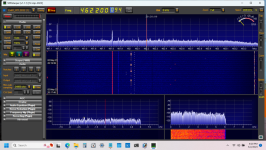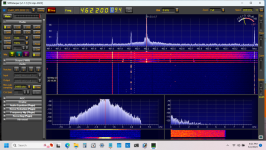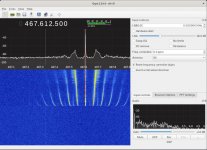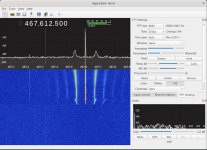You are using an out of date browser. It may not display this or other websites correctly.
You should upgrade or use an alternative browser.
You should upgrade or use an alternative browser.
Yaesu: Yaesu FT60R vs Baofeng UV5G
- Thread starter dkcorlfla
- Start date
- Status
- Not open for further replies.
I don't know that the technology is any more or less superior than the tech coming from other countries. Obviously, the Chinese can produce superior RF products, reference the Apple iPhone, but they have to be designed to a goal that includes spectral purity. When the goal is absolute lowest price, I suspect that the filters get left out as a "cost-saving" measure.Little/no filtering, stuff getting chucked out all over the band. Superior Chinese technology.
How do we know that it does? Does this Baofeng in question have an FCC ID number? Can we look it up in the FCC Equipment Authorization Database? If it's in the database, it should have a copy of the compliance testing lab's report. Of course, I say this somewhat tongue-in-cheek as we all know that the Baofeng importers mix and match FCC ID numbers. "Yes, we know the radio looks different and has different features, but we're gonna use the same FCC ID number that we got for a previous radio."There's no way that should be passing FCC specs.
Probably not.I also looked at 97.307 which is emission standards for amateur radio, and I can find requirements for HF and VHF but not UHF. Did I miss them?
47 CFR 97.307(c) states: "All spurious emissions from a station transmitter must be reduced to the greatest extent practicable. If any spurious emission, including chassis or power line radiation, causes harmful interference to the reception of another radio station, the licensee of the interfering amateur station is required to take steps to eliminate the interference, in accordance with good engineering practice."
47 CFR 97.307(e) states: "The mean power of any spurious emission from a station transmitter or external RF power amplifier transmitting on a frequency between 30–225 MHz must be at least 60 dB below the mean power of the fundamental...."
Since 97.307(e) doesn't address transmitters operating above 225 MHz, we have to fall back on 97.307(c).
And, I can state that I'm a wealthy Italian jet-setter with a yacht moored in the harbor at Monaco. What's the FCC ID number on the Baofengs you bought?I bought the pair because it was stated it meets FCC GMRS standards.
Ok, you have made me curious so I pulled the battery pack out and took a look. The FCC ID: 2AN62-UV5G. I also found that it was made by PO FUNG ELECTRONIC. So who or what is Baofeng? Did Baofeng make radios or is it a brand name? Maybe I have a clone?And, I can state that I'm a wealthy Italian jet-setter with a yacht moored in the harbor at Monaco. What's the FCC ID number on the Baofengs you bought?
I would love to know how to look up the FCC ID so any tips would be great.
Thanks, Dale
That looks interesting, I see a large trace on the waterfall from abt 461.1 to 463.2 MHz am I reading that correct? Also curious on the frequency used as that is below the GMRS channels. The radio should not have been able to TX on 462.200 unless it is an unlocked UV-5R.I just had to do it. A before and after TX with the Baofeng using SDR.
Freq = 462.200
The point of the post was to have fun, try to learn more and share what I found playing around with the HTs and my SDR.The point of this post is what? YouTube is full of spectrum analysis videos of various HT. The concern usually starts with the second harmonic, which would be over 900Mhz for a GMRS channel. Are you aware that GMRS typically uses wide-band transmission? Great you are having fun with your radios, but …
It wouldn’t be Radio Reference if people didn’t either pick your post apart or completely miss the humor of it or both.The point of the post was to have fun, try to learn more and share what I found playing around with the HTs and my SDR.
The first time I keyed up the HTs I was next to the computer and did think it could be overloading the SDR but I then used the delay timer on my computer so I could walk down the street with the same results. It was less intense down the street but still looked the same.How do you know the junk on the SDR display is real?
I would like to redo this test using my much better SDRplay but I'm having trouble getting it to work correct on UHF.
nd5y
Member
I also found that it was made by PO FUNG ELECTRONIC. So who or what is Baofeng? Did Baofeng make radios or is it a brand name? Maybe I have a clone?
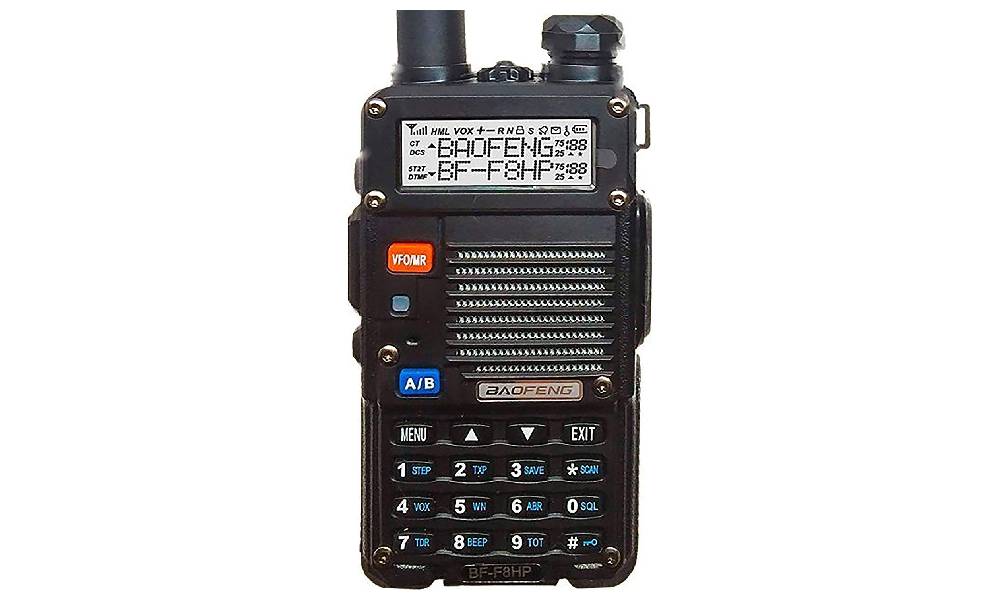
What was with the Confusing ‘Pofung’ Hype? ‣ BaoFeng Tech & BTECH Radios
October 3, 2020 ARLINGTON, SOUTH DAKOTA - WEDNESDAY, 7 OCTOBER 2015 What happened to ‘Pofung’? Back in 2014 there was a huge bombshell from BaoFeng: all future radios, that were exported out of China, were going to be branded as ‘Pofung’. But 2014 has come and gone; and we are almost through...
 baofengtech.com
baofengtech.com
Pofung Radios | Baofeng Radios - Product Information and Sales
Pofung Radios, formerly Baofeng Radios, are high quality dual-band radios that operate in the 136-174 MHz and 400-480 MHz Frequencies. This transceiver gives Amateur Radio (Ham Radio) Operators access to the 2 Meter (2M) and 70 Centimeter (440) bands. In addition, the Pofung Radios frequency...
pofungradios.com
Last edited:
Update - I ran the test on the second Baofeng/Pofung radio with different results. Note on the second test the LNA setting was lower as I had forgot I had lowered it for a 2 meter ham net last night. After I realized this I re-tested the first unit and it too looked better so it looks like some of the noise is getting amplified by the LNA (LNA low noise amp, also big noise amp) ;-)
What I find interesting is the difference between unit 1 and 2 as both came out of the same box.
What I find interesting is the difference between unit 1 and 2 as both came out of the same box.
Attachments
mmckenna
I ♥ Ø
That radio has a confusing mess of certifications.Ok, you have made me curious so I pulled the battery pack out and took a look. The FCC ID: 2AN62-UV5G. I also found that it was made by PO FUNG ELECTRONIC. So who or what is Baofeng? Did Baofeng make radios or is it a brand name? Maybe I have a clone?
I would love to know how to look up the FCC ID so any tips would be great.
Thanks, Dale
Running the 2AN62-UV5G through the FCC OET search page will give you the results. FCC ID Search
The results show that 136-174MHz and 400-520MHz range -only- has Part 15b certification. Part 15b is for the scanning receiver only, not the transmitter.
If you look at the GMRS channels listed on that page, it does show Part 95E certification -only- on those GMRS channels.
Also note that it shows an emissions designator of 9K84F3E which is a non-standard FM analog emission. Traditional narrow FM analog would be 11K0F3E. The 11K0 is the bandwidth part (11KHz, which keeps it inside the 12.5KHz narrow FM channels. The Bao/Po/Feng is running 9K84, which translates into 9.84KHz bandwidth, That's narrower than normal analog narrow band FM.
That can indicates a few things:
Running narrower bandwidth help a poorly aligned/poor QC radio still work and stay inside the emissions mask limits.
It means they have to put in less time doing QC and making sure the radio is aligned correctly as it goes down the "assembly line".
It also means that it is going to sound lower in volume compared to a radio running 11K0F3E
Also note, there is no 20K0F3E, which would be wide band (25KHz) FM. That means that the radio is not certified to run wide band FM on the GMRS channels where most repeaters/users are running wideband.
With only Part 15B on the receiver, and Part 95E on the transmitter, that requires that the radio only be used to transmit on GMRS channels. It can also transmit on ham radio frequencies as transmitter type acceptance is NOT required on the ham radio bands.
So, it would be a violation to use this radio to transmit anywhere outside of GMRS or amateur radio bands. It's not type accepted for Part 90, Part 80 or anything else.
mmckenna
I ♥ Ø
The point of the post was to have fun, try to learn more and share what I found playing around with the HTs and my SDR.
That is what this should be all about. Some -do- get offended, however, when we take a bit of a deep dive into the realities, rules and actual specifications on these radios.
I know not everyone has a lot of discretionary cash to spend on hobbies, and the CCR's are an option for many to get into amateur radio or GMRS without a big investment. There starts to be some confusion when some on the internet make a lot of noise about modifying the radios to use on Part 90 and other radio services when they don't meet the specs. Unfortunately there are those that will think that "it's on the internet, so it MUST be true!" and will start using these radios in places they should not be. I ended up with an uninformed user trying to use a couple of CCR's on a UHF LMR system, then proceeded to complain because the "repeater system sucked". When I brought in a true LMR radio designed for the application, as well as a service monitor to prove my point, they understood and replaced all the CCR's with appropriate radios. Life got easier for everyone after that.
I have no problem with hobbyists using these radios on the appropriate hobby bands. I'm sure if these had been around when I first got my ham ticket, I would have had one.
There are a select few, however, that have absolutely convinced themselves that these radios are as good as, if not better, than the products made by Motorola, Harris, Kenwood, etc. And they'll start arguing, even when proof is posted that they are not.
Keep these things where they belong and enjoy them.
mmckenna
I ♥ Ø
What I find interesting is the difference between unit 1 and 2 as both came out of the same box.
This is what I have noticed, and you give an excellent example.
The Quality Control sucks. I can take radios at work even radios 10+ years old, put them on a service monitor and get them all looking very much identical. Two new radios of the same model/brand straight out of the box from the factory should not look drastically different.
mmckenna
I ♥ Ø
I don't know that the technology is any more or less superior than the tech coming from other countries. Obviously, the Chinese can produce superior RF products, reference the Apple iPhone, but they have to be designed to a goal that includes spectral purity. When the goal is absolute lowest price, I suspect that the filters get left out as a "cost-saving" measure.
That was mostly an attempt at humor.
I do have some Chinese made Milwaukee power tools that have been running great for 12+ years.
The difference is that Milwaukee will pay extra for the quality control, better components and oversee the production.
The Chinese manufacturers are happy to build the same products much cheaper, but not do the QC or supervision of production. That's why you can go to Harbor Freight and get a very similar look and specification power tool and often get something very close to being equal. Other times, you'll get a dud right out of the box.
And, I can state that I'm a wealthy Italian jet-setter with a yacht moored in the harbor at Monaco. What's the FCC ID number on the Baofengs you bought?
You too?!?!? The weather has been awesome here in Monaco the last few days, hasn't it?
Looks like you did a better job of looking up the fcc id. I tried and did not pull up anything.That radio has a confusing mess of certifications.
Running the 2AN62-UV5G through the FCC OET search page will give you the results. FCC ID Search
Thanks for the info. I plan to only use the Baofeng/Pofung on GMRS. My understanding is if I re-flash it and re-program it for use on the ham band it will no longer be legal for GMRS. For portable ham vhf/uhf I have the Yaesu FT60R
It is troubling that it does not have a 25Khz cert for the repeaters.
mmckenna
I ♥ Ø
Looks like you did a better job of looking up the fcc id. I tried and did not pull up anything.
Thanks for the info. I plan to only use the Baofeng/Pofung on GMRS. My understanding is if I re-flash it and re-program it for use on the ham band it will no longer be legal for GMRS. For portable ham vhf/uhf I have the Yaesu FT60R
Correct. The FCC rules for Part 95, as well as Part 90 and others, do not permit functions like VFO in the radios. So, if one wanted to follow the FCC rules, once the radio is "modified" to allow VFO operation, it will void its type certification on the other services.
Usually anything that changes a radio like that to operate differently than it did right out of the box would void the type certs.
It is troubling that it does not have a 25Khz cert for the repeaters.
It may do it, but they didn't report it when submitting for the type certification. Wouldn't be the first time someone has fudged the documents.
I had to get the yacht moored early to save my spot for the Formula 1 race May 26-28.The weather has been awesome here in Monaco the last few days, hasn't it?
As for Chinese-made tools, Torque Test Channel and Project Farm on YouTube have done a lot of tests on various types of tools. The results, especially on the power tools, are eye-opening.
But, I wander off topic.
k6cpo
Member
47 CFR 97.307(c) states: "All spurious emissions from a station transmitter must be reduced to the greatest extent practicable. If any spurious emission, including chassis or power line radiation, causes harmful interference to the reception of another radio station, the licensee of the interfering amateur station is required to take steps to eliminate the interference, in accordance with good engineering practice."
47 CFR 97.307(e) states: "The mean power of any spurious emission from a station transmitter or external RF power amplifier transmitting on a frequency between 30–225 MHz must be at least 60 dB below the mean power of the fundamental...."
Since 97.307(e) doesn't address transmitters operating above 225 MHz, we have to fall back on 97.307(c).
There's one big flaw in the arguments being presented here. The OP is comparing a radio designed and built for the amateur service against one designed and built for GMRS. That's like comparing apples and oranges. The only thing apples and oranges have in common is that they are fruits. The only thing a Yaesu FT-60 and a GMRS Baofeng have in common is that they are radios. They operate in different services and don't even fall under the same set of regulations. The regulations quoted above are from Part 97, which applies to the amateur service. They, including 97.307(c), DO NOT apply to GMRS or the radios used there. GMRS has it's own set of regulations laid out under 47 C.F.R, Part 95 Subpart E.
I have to disagree with you. That UV-5G/UV-5X is the same radio with different firmware. Don't believe me? Do an Internet search and look for a video (which I shall not link to) where a guy modified his "GMRS" Baofeng to transmit on 2m, 1.25m, 70cm, and GMRS.There's one big flaw in the arguments being presented here. The OP is comparing a radio designed and built for the amateur service against one designed and built for GMRS.
Yes, and my original post referenced both Part 97 (for the Yaesu) and Part 95 (for GMRS).The regulations quoted above are from Part 97, which applies to the amateur service. They, including 97.307(c), DO NOT apply to GMRS or the radios used there. GMRS has it's own set of regulations laid out under 47 C.F.R, Part 95 Subpart E.
Because the person I replied to asked if he had missed something in Part 97.The regulations quoted above are from Part 97...
The implication in that statement is that the Yaesu is the Cadillac and that the only difference between the two is fit/finish/luxury/options and they both will get you where you want to go.Comparing a Cadillac to a Yugo would yeild these kind of results too...
However the reality here is that the Yaesu is the Yugo, and the BaoTurd is something which should never get cleared by the NHTSA for travel on US roads. Because the latter is unsafe to those around it.
"It works, doesn't it?" is a statement used by the ignorant who don't realize that there is more to the equation. You don't know what you don't know is a phrase that comes to mind. But what many who would argue in favor of the BingBong do know is their ego and the inability to admit fault at subjects they are unfamiliar with. Thus we end up with people who will 'die on this hill' defending their precious garbage.
K6CPO, this isn't in any way a personal attack on you, but a generalization based on similar statements made by people trying to compare apples to particle physics.
- Status
- Not open for further replies.
Similar threads
- Replies
- 29
- Views
- 2K
- Replies
- 3
- Views
- 477
- Replies
- 8
- Views
- 724


